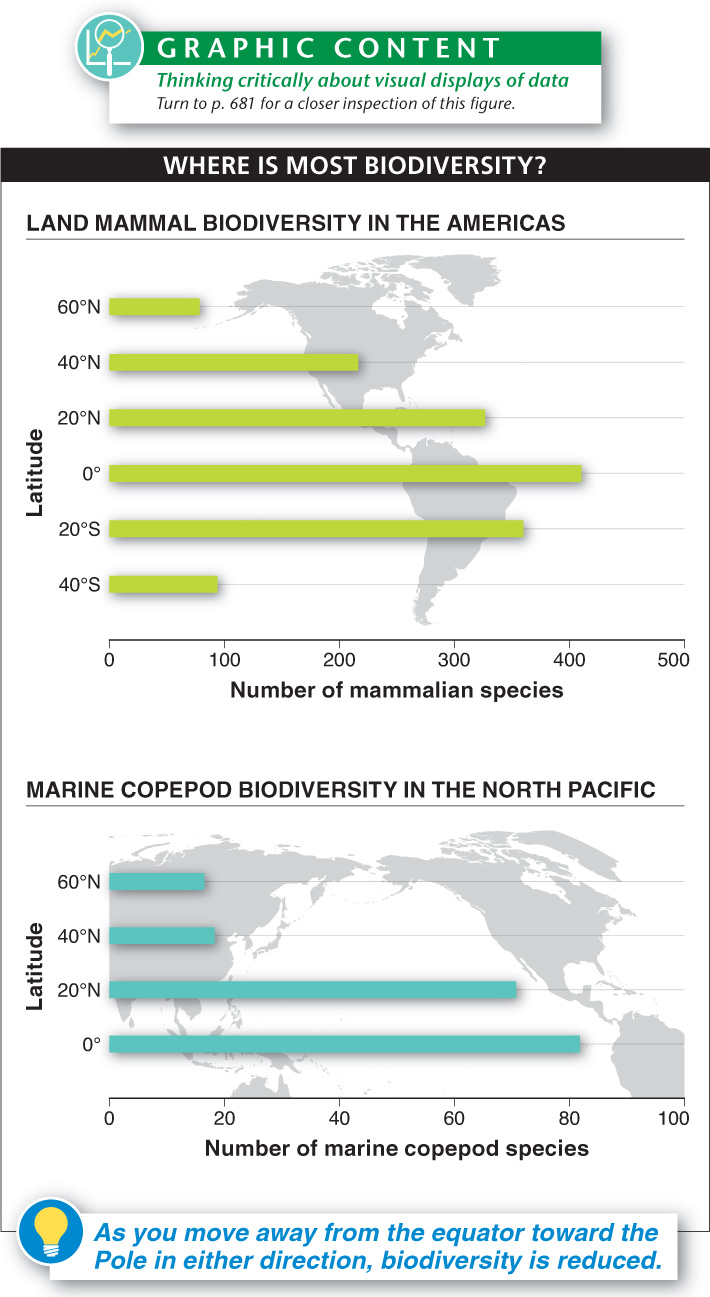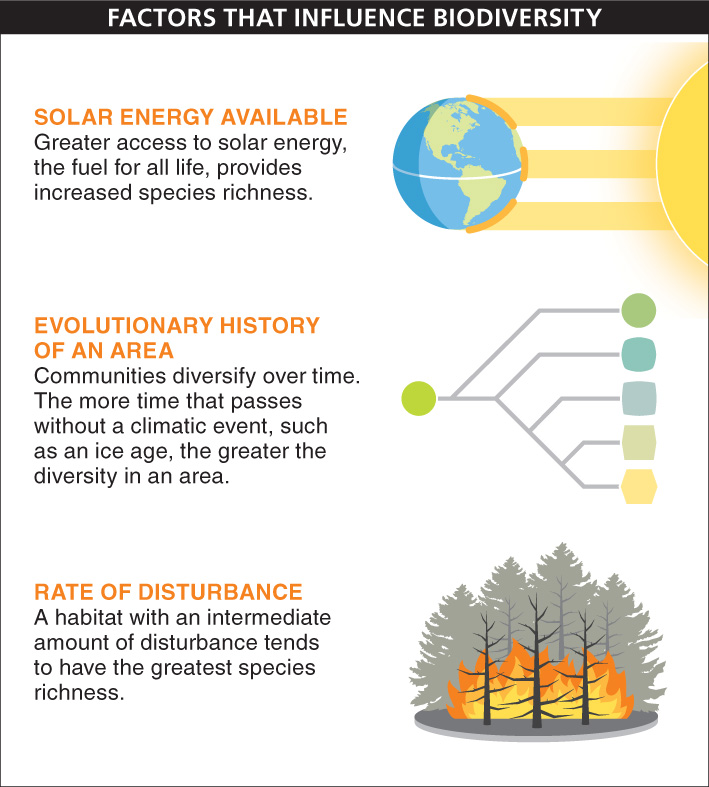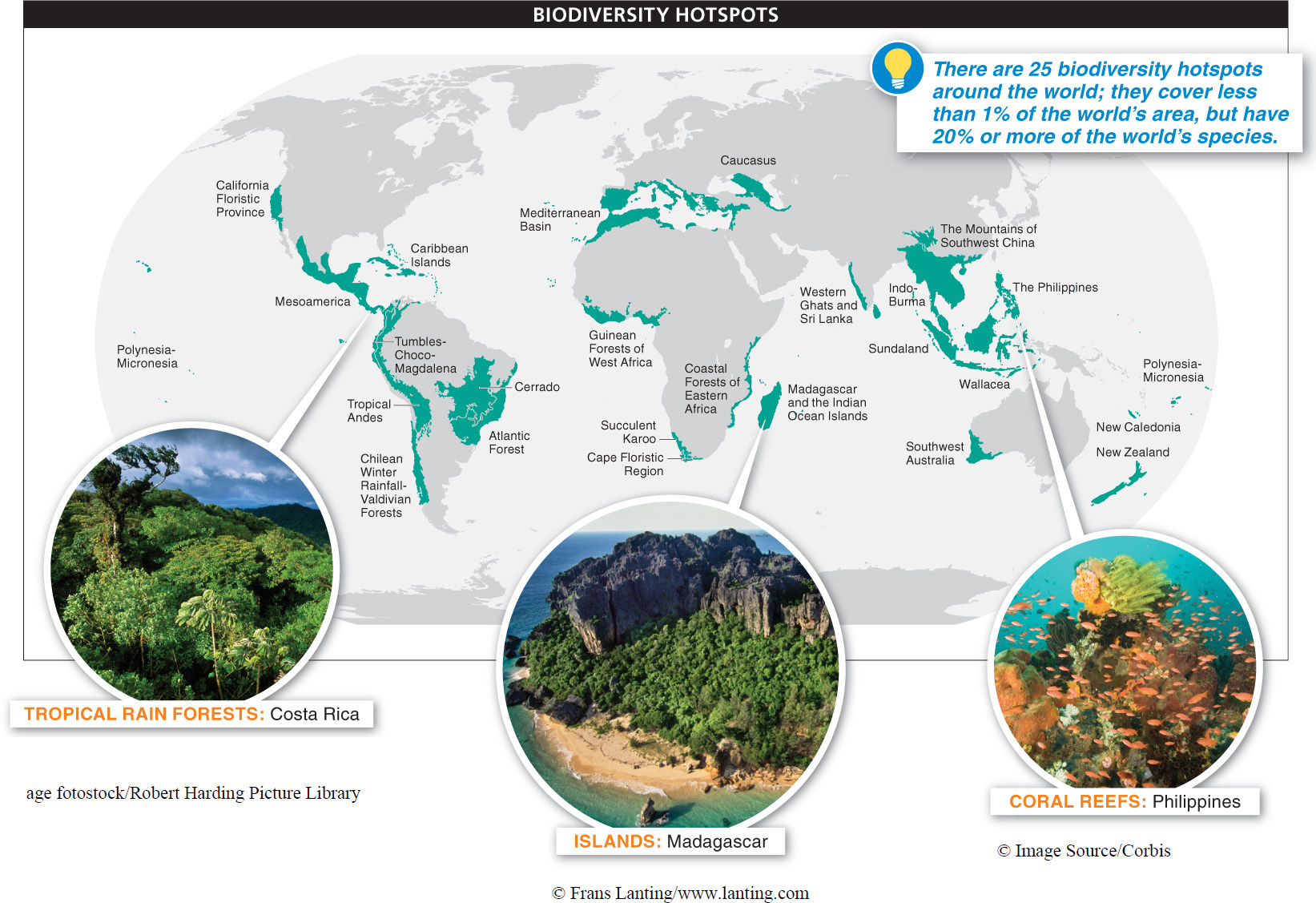If you were to stand at the equator in South America and identify the number of land mammals, you would count about 400 different species. If you then started walking southward, away from the equator, and assessed the diversity of land mammals when you got to 20° latitude, you would find about 350 different species. Continuing your long walk south, when you got to 30° latitude you would find only 200 different species. And the trend would continue for as far south as you could go, with 100 species at 40° latitude and fewer than 50 species at 50° latitude. On a similar walk northward from the equator, through North America, you would observe the same trend, with more than 300 species of land mammals at 20° latitude, reduced to only 100 species in northern Canada (FIGURE 16-6). Biodiversity is not evenly distributed throughout the world. And perhaps the strongest trend in terrestrial biodiversity distribution is this: as you move away from the equator in either direction, diversity is reduced with increasing latitude.

Why are there more species in an acre of tropical rain forest than in an acre farther from the equator, such as in a temperate forest or prairie?
The strong biodiversity gradient from the tropics to the Poles occurs not just in land mammals but in nearly any group of plants or animals observed—
656
Numerous factors that influence species richness— that is, the number of species in an area—

1. Solar energy available. Perhaps the simplest predictor of species diversity is the amount of solar energy available in an area. Solar energy is, after all, the ultimate fuel for nearly all life. As we saw in Figure 15-
2. Evolutionary history of an area. Communities diversify over time. Consequently, the more time that passes, generally speaking, the greater is the diversity in an area. A high level of biodiversity in an area, however, can be knocked back down by climatic disasters such as glaciations. Thus, for example, biodiversity declines due to glaciations may have disproportionately occurred in temperate and polar regions (and on the tops of some mountains), which have been affected more frequently than tropical regions as glaciers have advanced and retreated over hundreds of millions of years.
3. Rate of environmental disturbance. Over time, the best competitor for a resource is expected to outcompete other species, excluding them from the community and reducing species richness. However, communities may be kept from reaching this species-
Conservation biologists are increasingly interested in biodiversity hotspots, those regions of the world having significant reservoirs of biodiversity that are under threat of destruction. Twenty-

Tropical Rain Forests These habitats are common near the equator in Asia, Australia, Africa, South America, and Central America, as well as on many Pacific islands. An important, but still poorly studied, region of tropical rain forests is the canopy, the uppermost region of a forest, where nearly all of the sunlight is intercepted. The canopy, which can be up to 30 feet (almost 10 m) thick, is the most diverse part of the tropical rain forests; estimates suggest that as many as half of all species on earth reside in the canopy of these rain forests. Due to its inaccessibility—
Coral Reefs Built by corals, members of the animal kingdom, coral reefs occur in ocean areas with low levels of nutrients. The physical structures created by the corals provide a home and habitat for huge numbers of other species. The Great Barrier Reef of Australia (which is not listed among the 25 biodiversity hotspots because it currently is a focus of extensive conservation efforts) is an example of just how much diversity can be supported by coral reefs. It is the largest coral reef system in the world and covers such a large area (almost the size of California) off the northeast coast of Australia that it can be seen from space. It is home to numerous species of whales, dolphins, sea turtles, sharks, and stingrays, as well as 1,500 species of fishes and 5,000 species of mollusks. Five hundred species of algae are found there, too. Above the Great Barrier Reef, more than 200 species of birds are supported by the rich diversity of life below. Other coral reefs are not as well protected by laws and conservation efforts, and the world’s second largest coral reef, in New Caledonia in the southwestern Pacific, is one of the 25 biodiversity hotspots.
657
Islands Because of their generally smaller size, which limits the population size of organisms living on them, islands can be regions where biodiversity is at risk. Madagascar, located in the Indian Ocean off the southeastern coast of Africa, is the fourth largest island in the world (just a bit smaller than Texas). It is home to 5% of the world’s species, 80% of which are endemic (exclusively native to a place)—a higher percentage of endemic plants and animals than in any comparably sized area on earth. One of the 25 biodiversity hotspots, Madagascar is an area unusually rich in species diversity.
Deep Oceans The oceans, covering two-
TAKE-HOME MESSAGE 16.4
Biodiversity is not evenly distributed over the earth. For nearly all groups of plants and animals, both marine and terrestrial, biodiversity is greatest near the equator and falls progressively toward the North and South Poles. Factors that influence the species richness in an area include the amount of solar energy available, the area’s evolutionary history, and the rate of environmental disturbance. Biodiversity hotspots are regions of significant biodiversity under threat of destruction.
What factors influence species richness? Why is there greater biodiversity near the equator?
Three factors play a strong role: (1) available solar energy (the “fuel” for life); (2) the evolutionary history of an area (the more time evolution has had to work within a community); and (3) the rate of environmental disturbance (intermediate levels of disturbance work in favor of greater species diversity, whereas low disturbance levels favor strong competitors dominating a community and high disturbance levels favor only a few hardy species). It just so happens that near the equator, these 3 factors coincide and support the greatest biodiversity of life on earth.
658